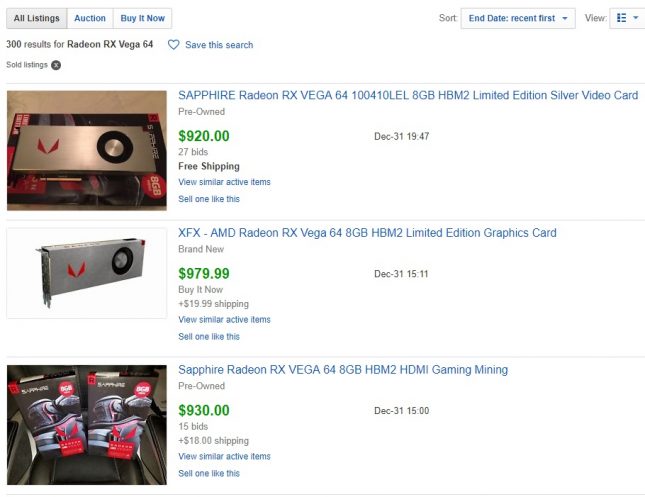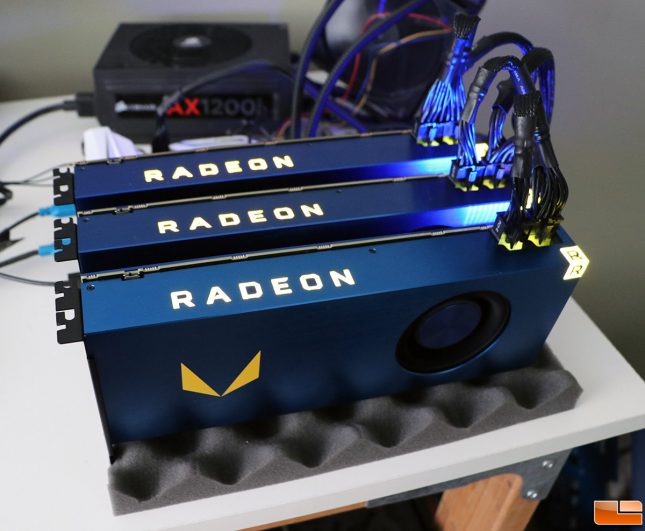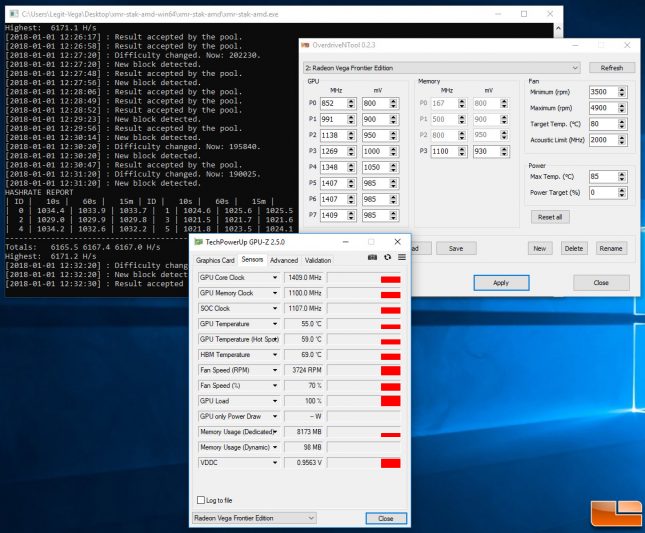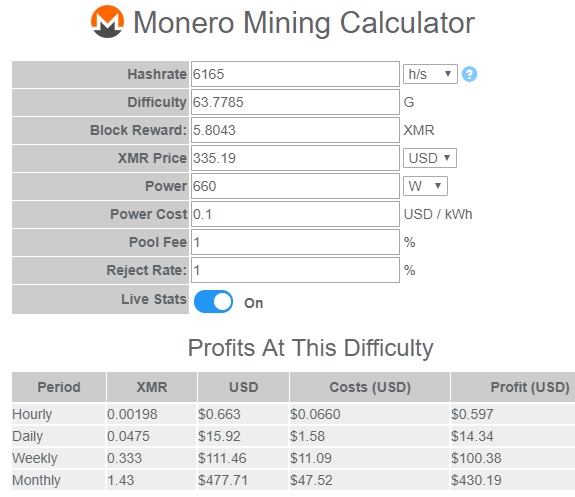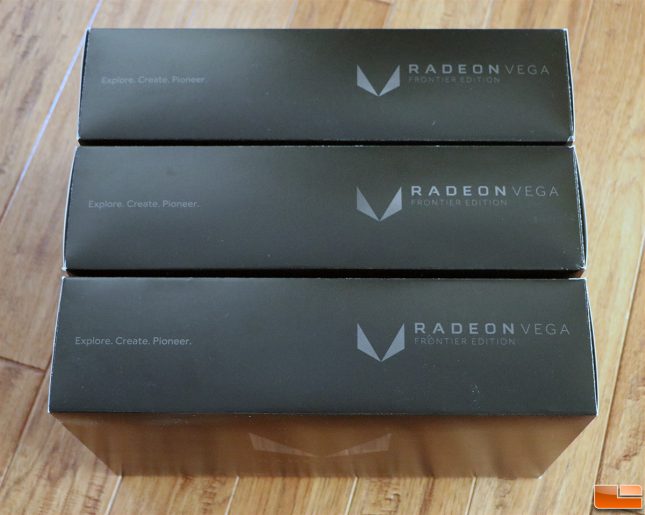Mining XMR Monero With AMD Radeon Vega Frontier Edition Cards – Over 2050 H/s
AMD Radeon RX Vega graphics cards do very well on the CryptoNight proof-of-work algorithm and miners are using them to mine Monero, Electroneum, Sumokoin, Bytecoin and Karbo. This is because the profitability is better on those coins than Ethereum that uses the Ethash proof-of-work algorithm. It’s tough to find an AMD Radeon RX Vega 64 or AMD Radeon RX Vega 56 graphics card due to this. You might get lucky and find some in-stock at Amazon or Newegg, but it is tough. If you switch tactics and look for used AMD Radeon RX Vega 64 cards on eBay you’ll quickly find that they are selling for well over $900.
Paying close to $1,000 for a new or used AMD Radeon RX Vega 64 is crazy considering you could pick one up for just under $570 direct from Amazon in November 2017. What is the mining alternative to the AMD Radeon RX Vega 64 and Vega 56 cards?
Meet the AMD Radeon Vega Frontier Edition (product page). This card was introduced back in June 2017 for $999 and was targeted at data scientists, immersion engineers, and product designers rather than gamers. AMD must be sitting on a pile of Radeon Vega Frontier Edition graphics cards that they are trying to move as they recently started marketing the card for “blockchain pioneers’ and the street pricing has been slashed to $749.99 shipped at places like Newegg to possibly get them moving. That doesn’t bode well for resale value, but it should be worth mentioning that these cards are in-stock at $749. They have 64 compute units with 4,096 stream processors clocking at up to 1600 MHz and are loaded up with 16GB of HBM2 memory that has 483 GBps of memory bandwidth at stock speeds. They overclock just like the Radeon RX Vega 64 cards, so you can take that 16GB of HBM2 memory up to the 1050-1100 MHz range on most cards and get over 2000 H/s per card like a Vega 64.
We gave up trying to get several AMD Radeon RX Vega 64 cards and managed to get three AMD Radeon Frontier Edition cards and slapped them onto a test system. Our system consists of the following hardware:
- ASUS Z170 Deluxe Motherboard – $225 shipped
- Intel Celeron G3930 Processor – $43.99 shipped
- Drevo X1 Pro 64GB SSD – $39.99 shipped
- 16GB DDR4 2400MHz Corsair Vengeance Memory – $179.00 shipped
- AMD Radeon Vega Frontier Edition Air Cooled – $749.99 shipped (each)
- Corsair AX1200i Power Supply – $299.99 shipped
- open air case (aka table)
After fighting the cards a bit we managed to get all three cards working with pretty good stability and are getting 6,165 H/s on the XMR-STAK-AMD mining utility by overclocking the cards memory up to 1100 MHz at 930 mV. This puts us at roughly 2,055 H/s per Vega Frontier Edition card, which is excellent. Total system power draw at the wall is around 660 Watts with these settings. We are still tweaking this setup to make it more efficient. Right now we are doing a 24-hour mining test with the P7 core clock at 940 mV and that drops the overall system power down to roughly 620 Watts and the total hashrate to 6,145 H/s.
According to the Monero Mining Profit Calculator over at MyCryptoBuddy this setup will make $15.92 per day and after electric costs ($0.10 per kWh) we are looking at a profit of $14.34 per day. Last month when the difficulty was half of what it is now you would have been making around $32 per day in profit. The difficulty is going up, but hopefully the price of XMR will increase to help keep the profits per day up to where miners will be happy. Some Monero price prediction sites are showing that Monero will top $900 in 2018 and $3000 in 2020. We don’t have a crystal ball to know where the price of XMR Monero is going, but if those predictions come close to being right it will make many miners extremely happy.
Hopefully this article helps those that are looking to buy and AMD Radeon RX Vega series card to mine with. Please don’t pay insane prices for AMD Radeon RX Vega 64 or Vega 56 cards when you can purchase the AMD Radeon Vega Frontier Edition for $749.99 shipped. We’d much rather own the Vega FE at $749 versus a used Vega 64 Air Cooled card for $920+ dollars. The ideal situation would be to find a Vega 64 or Vega 56 card for under $600 like they were back in November 2017. Mining with Vega FE cards is pretty tricky and are best done in a dedicated mining system due to the setup complexity. These cards are great for mining, but they aren’t for the gamer that is interested in mining in their spare time due to the fact that you have to run six month old blockchain drivers among other things. That said, I’m tempted to pick up some risers and a couple more cards with the hopes of getting 10,000 H/s from this system!
We will end this with some tips for those that actually run out and purchase AMD Radeon Vega FE cards to mine with!
Setting up a single AMD Radeon Vega FE to mine is simple, but setting up more than one of them to mine was a bit tricky. Here is what we learned over the course of a week to get multiple AMD Radeon Vega FE graphics cards together on one platform.
- Clean install of Windows 10 Fall Creators with all necessary drivers
- Set the display and system to never turn off in Windows power options.
- Follow some of the online guides to increase virtual memory size and other tweaks you feel necessary (two great ones are here and here)
- Download AMD Software Crimson ReLive Edition Beta for Blockchain Compute GPU drivers (link)
- Install the drivers along with Radeon Settings and reboot (this goes against many of the online guides, but they aren’t running Vega FE cards and the regedit hacks don’t work)
- After rebooting you’ll need to go into Radeon Settings and disable CrossFire in Wattman. It only shows up on one card, so find it and disable it.
- Reset Vega drivers with device manager by disabling and enabling each card. You can write a script to do this automatically. If you get errors ensure you are using a 1080P 60Hz display with the HDMI port. A 144Hz gaming display wrecked our hashrate as did a display with NVIDIA G-Sync. We found we had better hashrate stability on HDMI over Displayport.
- Run xmr-stak-amd to start mining and verify your performance. It should be around 1700-1800 H/s at this point per card with the intensity set at 2000/2000 per card.
- Overclock the Vega FE cards in your system with OverDrivenTool
- Keep your miner running. Set your fans. For now, set the Min to 3500. Drop P7 CLK to 1407 MHz. Apply. Wait 30s and observe that H/s is stable. Drop your P7 Voltage by 50 mV. Apply. Wait 30s again, observe H/s stability. Repeat the above 2 steps until you hit 1 V. Depending on your luck, you can go down to 950 or even 900 mV (Rare).
- Next is the memory overclock. Keep the voltage the same. Instead of increasing voltage, increase your memclock by steps of 10. If youre lucky, you should end up in the 1050-1100 MHz range. You can also reduce the voltage here as well, but take small increments. 950 mV is common, 900 mV is lucky.
- With 1407 MHZ @ 950 mV GPU + 1100 MHz @ 950 mV MEM, the hashrate should be around 2050 H/s per card. Continue to tweak these settings to get the best performance and efficiency that you can.
- Don’t use GPU-Z to monitor temperatures like we showed in the article. It kills your hashrate!
- If your hashrate drops drastically it might be due to heat on the HBM. Try to keep it under 70C.
- About once a day we notice that our overclocks get dropped from a Vega FE card. We leave OverDrivenTool open and just re-apply a saved overclock profile on the card that went back to stock speeds.
- If you need to restart the system or it crashes for any reason go into OverDrivenTool and reset each of the cards. Then disable/enable each card in device manager and then re-apply the OverDrivenTool profile.
- Buy a P3 P4400 Kill A Watt power meter ($18.53 shipped) as it will allow you to dial in the system for efficiency and you can see if a cards profile dropped by the power increase.
- Don’t want to run a monitor 24/7? Invest in an HDMI display emulator ($8.39 shipped for one or $6.50 each for two)
If you need any help or have any questions be sure to leave them in the comment section below.

